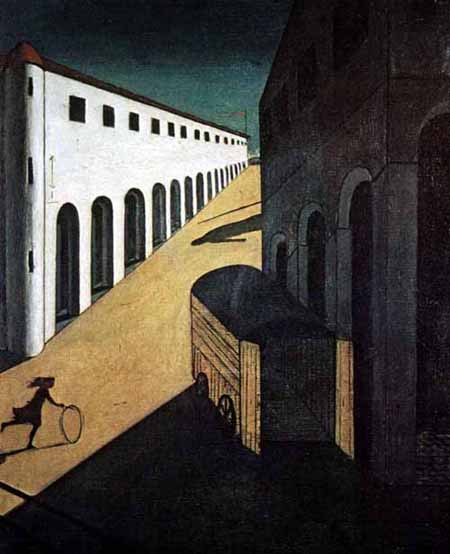 By SIMONE SECCI ROME CORRESPONDENT Who was Giorgio de Chirico and why should you care? You bet. Almost certainly, the ’50s American school of Abstract Expressionism wouldn’t even existed without him. Considering that this Italian artist whose career was extremely long but so shortly relevant to art history probably seriously influenced the most important surrealist artists of the day, people such as Max Ernst and Salvador Dali. And so it followed that surrealism created a birth place for the upcoming American Abstract Expressionism, people like Jackson Pollack and William De Kooning. But his influence doesn’t just end in the American 1950s, no the poetics of de Chirico’s early 20th Century paintings continue to resonate in this modern world nearly a century later. Can you say R-o-b-y-n H-i-t-c-h-c-o-c-k? Sure you can. His paintings always seem center around vast lonely squares and infinite vistas, shot thru with the memories of the collective unconsciousness, puzzled over and over again, and always symbols of time such as the phantom trains running in the background evoking the anxiety of death. Constantly, the modern world tries to escape its daily horrors — not least of all the ultimate knowledge that all that is now living will one day die — with the alienation of the mind. I think that is as good as any explanation of de Chirico’s endlessly intriguing mystery paintings: Lost in his own world of imaginary cityscapes populated by the ghosts of Greek classicism as memories of his childhood, living an unreal, eternal afternoon, as fascinating as it is horrifying, and for this reason impossible to exist. But a fella can dream, can’t he?
By SIMONE SECCI ROME CORRESPONDENT Who was Giorgio de Chirico and why should you care? You bet. Almost certainly, the ’50s American school of Abstract Expressionism wouldn’t even existed without him. Considering that this Italian artist whose career was extremely long but so shortly relevant to art history probably seriously influenced the most important surrealist artists of the day, people such as Max Ernst and Salvador Dali. And so it followed that surrealism created a birth place for the upcoming American Abstract Expressionism, people like Jackson Pollack and William De Kooning. But his influence doesn’t just end in the American 1950s, no the poetics of de Chirico’s early 20th Century paintings continue to resonate in this modern world nearly a century later. Can you say R-o-b-y-n H-i-t-c-h-c-o-c-k? Sure you can. His paintings always seem center around vast lonely squares and infinite vistas, shot thru with the memories of the collective unconsciousness, puzzled over and over again, and always symbols of time such as the phantom trains running in the background evoking the anxiety of death. Constantly, the modern world tries to escape its daily horrors — not least of all the ultimate knowledge that all that is now living will one day die — with the alienation of the mind. I think that is as good as any explanation of de Chirico’s endlessly intriguing mystery paintings: Lost in his own world of imaginary cityscapes populated by the ghosts of Greek classicism as memories of his childhood, living an unreal, eternal afternoon, as fascinating as it is horrifying, and for this reason impossible to exist. But a fella can dream, can’t he?
Curated News, Culture And Commentary. Plus, the Usual Sex, Drugs and Rock n' Roll

